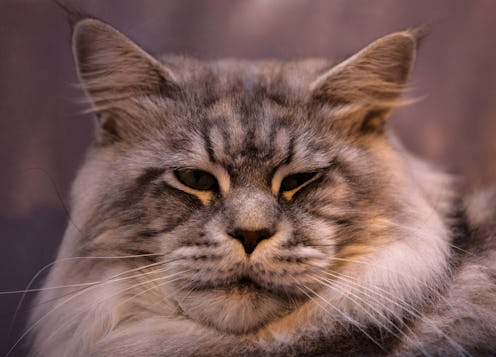News
Your Cat Is Closer To A Wild Animal Than You Think
We have degraded our cats. We put them in tights, dress them up as sushi for Halloween, and have perpetuated a myth of laziness that makes it difficult to believe that Mr. Mittens could be at all related to the magnificent lions and tigers that reign over their domains. But according to a new study, your house cat is just barely more domesticated than the wildcats of the African grasslands. Their DNA shows that house cats were tamed using treats and strokes, and as they began identifying sensations of reward and pleasure, they began warming up to us.
If your cat is anything like mine, she just doesn't need you. Except, of course, when it comes to the occasional scratch behind the ears and her favorite salmon treats. I'll be honest, this makes me feel a bit used every once in a while, but scientists from Washington University in St. Louis are now suggesting that this sort of behavior is quite literally hardwired into the animals. Cats, which are otherwise self-sufficient animals, first indicated signs of positive human interaction around 9,000 years ago when they were originally lured, I mean accepted, into human households by way of scraps of meat and loving attention.
Unlike dogs, which are known for their loyalty and complete devotion to their human masters, cats seem far less invested in their pet-owner relationships. But whereas cats have only been around for 9,000 years, dogs were first domesticated around 32,000 years ago in Europe. This means that dogs, as human companions, predates even the earliest emergence of agriculture. So it's little wonder that canines seem much more interested and accustomed to humans than our persnickety felines — they've just been with us for a lot longer.
Wes Warren, the leading author on the new study examining cat domestication, told the International Business Times, "Cats, unlike dogs, are really only semi-domesticated. They only recently split off from wild cats, and some even still breed with their wild relatives." As such, it was surprising for scientists to discover that there is actual genomic evidence that maps the history of how cats came to live with humans.
The tactics our early ancestors used are similar to the tactics we still use today. The only way to get my cat to come out from underneath the couch is with the promise of a meal, and according to science, this is because her early ancestors were wooed with the same promise. Dr. Bronwen Aken, one of the researchers involved from the Wellcome Trust Sanger Institute in Cambridge, told the Guardian,
You can imagine wild cats picking up scraps of food from near to human settlements initially and gradually becoming more accustomed to human presence. They would have moved in closer to the point where they were being fed. The food would probably have been the primary reward and petting would have come later.
Humans initially developed a need for cats in order to control rodent infestations, and to entice their newfound mice-killers to stick around for a while, we began feeding them, then petting them, and finally, loving them to no end. The cats that were most likely to take the bait, scientists say, are those that developed "neurons that are key to producing dopamine – the so-called pleasure hormone." When comparing the DNA of today's domestic house cat with say, a panther, researchers say there are differences in 13 key genes that are generally related to fear conditioning, memory, reward and pleasure.
This means that the first house cats were those who were less afraid of humans, able to remember their "owners" and the specific activities that garnered them praise, attention and food, and finally, capable of responding strongly to treats like food and loving attention. Researchers wrote, "Our results suggest that selection for docility, as a result of becoming accustomed to humans for food rewards, was most likely the major force that altered the first domesticated cat genomes."
But in spite of all these genetic changes, our cats are still much more closely related to their larger cousins than we would like to believe. Dr. Aken noted that many house cat habits remain eerily similar to those of wildcats, telling the Guardian, "...when you look at cheetahs and lions in Africa, you can still see a lot of similarities in their body language like the way they flick their tails when annoyed." Cats also never rid themselves of their predatory instinct, which explains why your supposedly domesticated house cat will still hunt and kill mice and small birds if given the opportunity.
Along with their killer instinct, cats also retained their fiercely independent traits, as evidenced by a recent study that found that while cats can recognize their owner's voice and their own name, they actively choose not to respond because they just "never evolved enough to care." Scientists explained, "Historically speaking, cats, unlike dogs, have not been domesticated to obey humans'orders. Rather, they seem to take the initiative in human-cat interaction." So if it feels like you're constantly seeking out your cat for attention, and not the other way around, don't worry — it's not you, it's nature.
The only question left to answer, researchers note, is why we're still so obsessed with animals who just couldn't care less about us.
Images: Getty Images (5)
